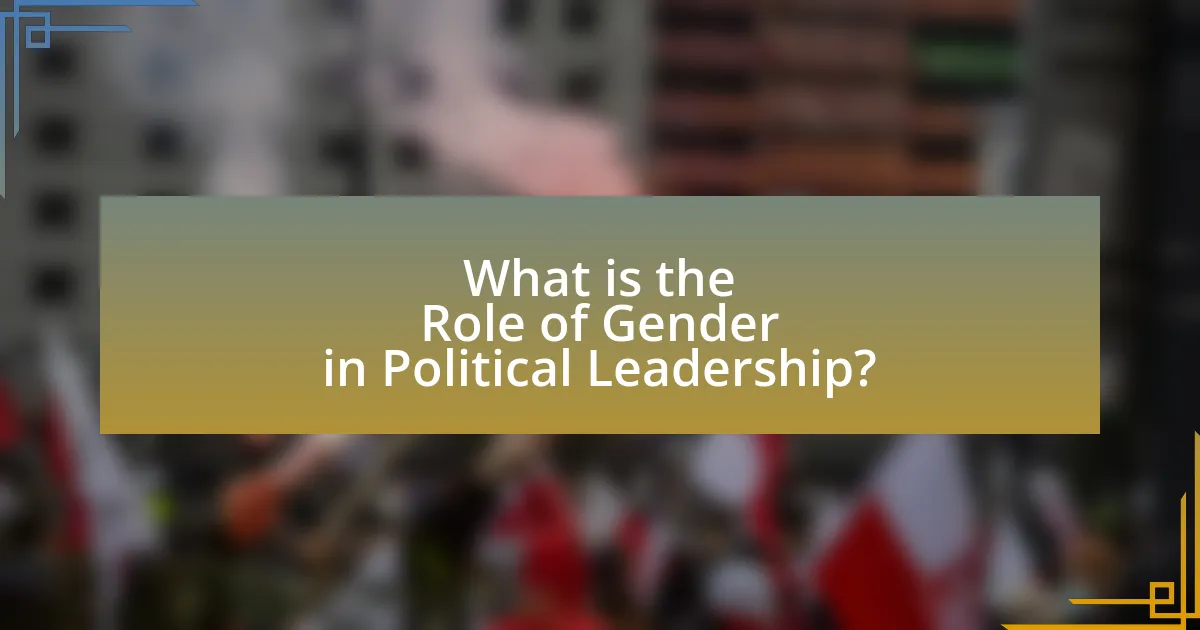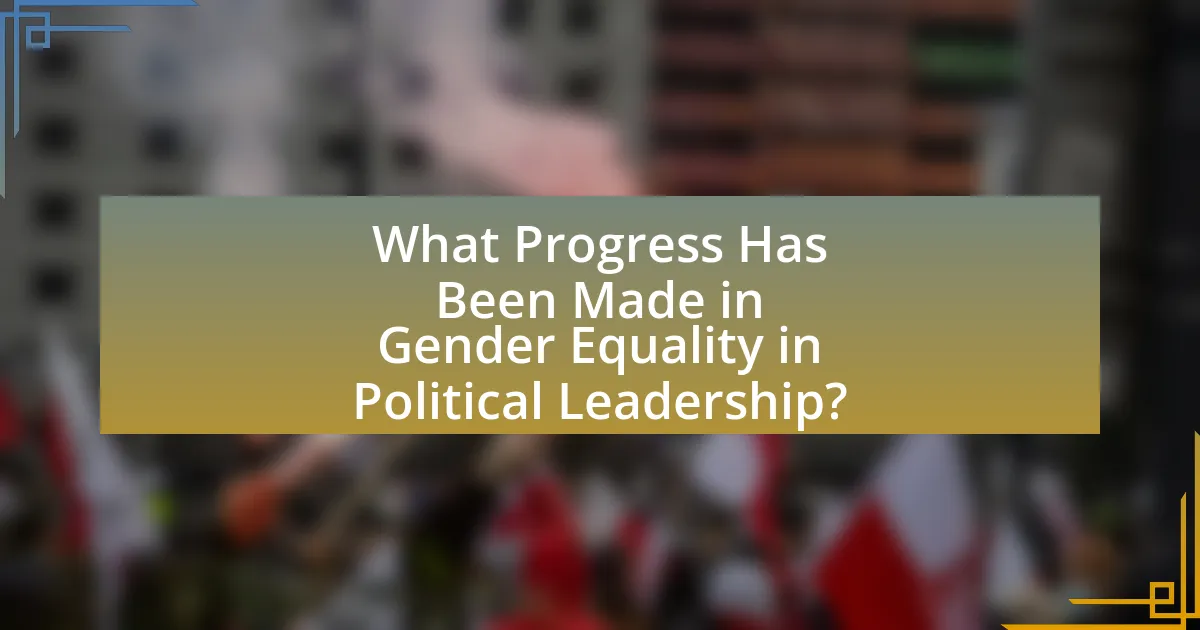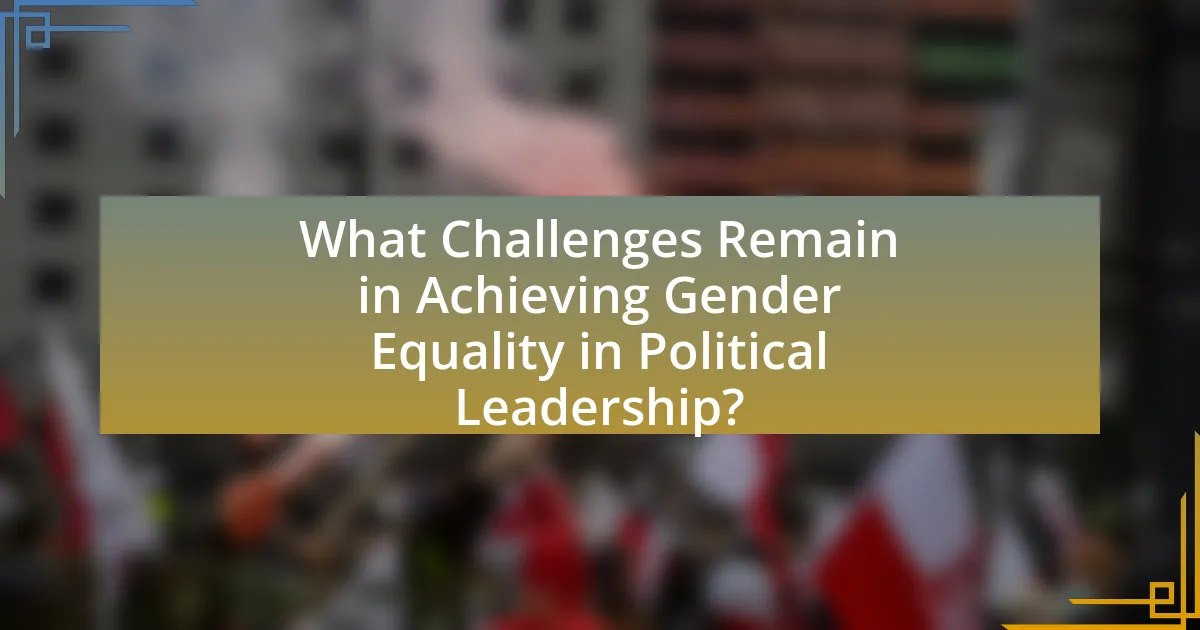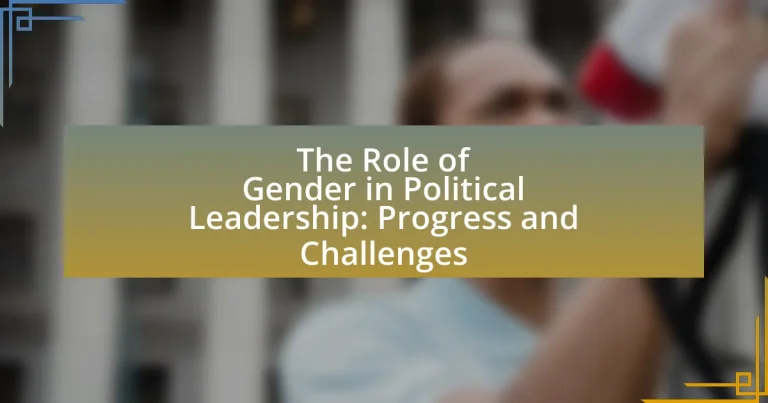The article examines the role of gender in political leadership, highlighting its impact on representation, decision-making, and policy priorities. It discusses the evolution of perceptions regarding women’s capabilities in leadership, historical milestones that have shaped gender roles, and the influence of cultural contexts on gender perceptions. The article also addresses the importance of gender representation in governance, the challenges women face in political roles, and successful initiatives that promote women’s participation in politics. Additionally, it outlines the systemic barriers and biases that hinder women’s advancement and suggests practical steps for promoting gender equality in political leadership.

What is the Role of Gender in Political Leadership?
Gender plays a significant role in political leadership by influencing representation, decision-making, and policy priorities. Women in leadership positions often advocate for issues such as gender equality, healthcare, and education, which can lead to more inclusive governance. For instance, research by the Inter-Parliamentary Union shows that countries with higher percentages of women in parliament tend to have more progressive policies on social issues. Additionally, gender diversity in leadership can enhance collaboration and innovation, as diverse perspectives contribute to more comprehensive solutions.
How has the perception of gender in political leadership evolved over time?
The perception of gender in political leadership has evolved significantly, transitioning from a predominantly male-dominated view to a more inclusive recognition of women’s capabilities. Historically, women were largely excluded from political roles, with societal norms reinforcing the belief that leadership was inherently masculine. However, the late 20th century saw a shift, marked by increased advocacy for gender equality and the rise of female political figures, such as Margaret Thatcher and Angela Merkel, who demonstrated that women could effectively lead at the highest levels.
Statistical evidence supports this evolution; for instance, the percentage of women in national parliaments worldwide rose from 11% in 1995 to approximately 25% in 2021, according to the Inter-Parliamentary Union. This change reflects a growing acceptance of women in leadership roles, influenced by broader social movements advocating for gender equality and women’s rights. As a result, contemporary perceptions increasingly recognize the value of diverse leadership, acknowledging that gender does not determine one’s ability to govern effectively.
What historical milestones have influenced gender roles in political leadership?
Historical milestones that have influenced gender roles in political leadership include the suffrage movements, the establishment of gender quotas, and landmark legislation promoting gender equality. The suffrage movements, particularly in the early 20th century, led to women gaining the right to vote in various countries, such as the United States in 1920 and the United Kingdom in 1928, fundamentally altering the political landscape and enabling women’s participation in leadership roles. The introduction of gender quotas in countries like Norway in 2003, which mandated a minimum percentage of women on corporate boards, further advanced women’s representation in political leadership. Additionally, legislation such as the Equal Pay Act of 1963 in the United States aimed to eliminate wage disparity based on gender, thereby supporting women’s advancement in political and professional spheres. These milestones collectively contributed to reshaping societal perceptions of gender roles in political leadership.
How do cultural contexts shape gender perceptions in political leadership?
Cultural contexts significantly shape gender perceptions in political leadership by influencing societal norms, values, and expectations regarding gender roles. For instance, in cultures with traditional gender roles, women may be perceived as less capable leaders, which can hinder their political participation and advancement. Research by Eagly and Karau (2002) in “Role Congruity Theory” indicates that women face bias when they violate traditional gender expectations, leading to negative evaluations in leadership roles. Conversely, cultures that promote gender equality tend to support women’s leadership, as seen in Nordic countries, where women hold a substantial percentage of parliamentary seats. This demonstrates that cultural attitudes directly impact the acceptance and effectiveness of women in political leadership positions.
Why is gender representation important in political leadership?
Gender representation is important in political leadership because it ensures diverse perspectives and experiences are included in decision-making processes. Research indicates that when women are represented in leadership roles, policies tend to be more inclusive and address issues such as healthcare, education, and family welfare more effectively. For instance, a study by the Inter-Parliamentary Union found that countries with higher female representation in parliament are more likely to pass legislation that promotes gender equality and social welfare. This demonstrates that gender diversity in political leadership not only reflects the population but also enhances the quality of governance and policy outcomes.
What impact does gender diversity have on decision-making processes?
Gender diversity positively impacts decision-making processes by enhancing creativity, improving problem-solving, and leading to more comprehensive perspectives. Research indicates that diverse teams are 35% more likely to outperform their homogeneous counterparts in decision-making scenarios. This is attributed to the variety of viewpoints and experiences that individuals bring, which fosters innovative solutions and reduces groupthink. A study published in the Harvard Business Review found that companies with higher gender diversity in leadership roles experienced a 15% increase in profitability, demonstrating the tangible benefits of inclusive decision-making.
How does gender representation affect public policy and governance?
Gender representation significantly influences public policy and governance by ensuring diverse perspectives are included in decision-making processes. When women are represented in political leadership, policies tend to prioritize issues such as healthcare, education, and family welfare, which are often overlooked in male-dominated environments. Research by the Inter-Parliamentary Union indicates that countries with higher female representation in parliament are more likely to pass legislation promoting gender equality and social welfare. For instance, Rwanda, with over 60% female representation in its parliament, has implemented progressive policies on maternal health and gender-based violence, showcasing the direct impact of gender representation on effective governance.
What challenges do women face in political leadership roles?
Women face significant challenges in political leadership roles, including systemic barriers, gender bias, and a lack of representation. Systemic barriers manifest in the form of institutional practices that favor male candidates, often resulting in fewer opportunities for women to ascend to leadership positions. Gender bias is prevalent in the form of stereotypes that question women’s competence and authority, which can undermine their credibility and effectiveness. Additionally, women are often underrepresented in political institutions, with only 26.1% of parliamentary seats held by women globally as of 2021, according to the Inter-Parliamentary Union. This lack of representation can perpetuate a cycle where women’s voices and perspectives are marginalized in policy-making processes.
What barriers exist for women aspiring to political leadership?
Barriers for women aspiring to political leadership include systemic discrimination, lack of access to networks, and societal stereotypes. Systemic discrimination manifests in political institutions that often favor male candidates, limiting women’s opportunities for advancement. Research indicates that women are underrepresented in political offices globally, with only 26% of parliamentary seats held by women as of 2021, according to the Inter-Parliamentary Union. Additionally, women frequently face challenges in accessing influential networks that are crucial for political campaigning and support. Societal stereotypes further hinder women’s political ambitions, as traditional gender roles often discourage women from pursuing leadership positions. These barriers collectively contribute to the ongoing underrepresentation of women in political leadership roles.
How do societal attitudes towards women influence their political careers?
Societal attitudes towards women significantly influence their political careers by shaping perceptions of their capabilities and roles in leadership. Negative stereotypes and biases can lead to underrepresentation of women in political positions, as evidenced by the fact that women hold only about 26% of parliamentary seats globally, according to the Inter-Parliamentary Union. Additionally, societal expectations often prioritize traditional gender roles, which can discourage women from pursuing political ambitions or result in their qualifications being undervalued. This systemic bias is reflected in studies showing that women candidates face more scrutiny and criticism than their male counterparts, impacting their electoral success and career advancement.

What Progress Has Been Made in Gender Equality in Political Leadership?
Significant progress has been made in gender equality in political leadership, evidenced by an increase in the number of women holding political office globally. As of 2023, women occupy approximately 26% of parliamentary seats worldwide, a notable rise from just 11% in 1995, according to the Inter-Parliamentary Union. Additionally, the number of female heads of state and government has also increased, with 15 women serving as heads of government in various countries, reflecting a growing acceptance of women in leadership roles. This progress is supported by various initiatives and policies aimed at promoting gender parity, such as quotas and gender-sensitive electoral reforms, which have been implemented in numerous nations to enhance women’s representation in politics.
How have women’s political participation rates changed in recent years?
Women’s political participation rates have increased in recent years, with a notable rise in the number of women elected to political offices globally. According to the Inter-Parliamentary Union, as of 2023, women hold 26.1% of parliamentary seats worldwide, up from 23.4% in 2019. This upward trend reflects ongoing efforts to promote gender equality in politics, including initiatives like gender quotas and advocacy for women’s rights. Additionally, the United Nations reports that women’s representation in local governments has also improved, indicating a broader shift towards inclusivity in political leadership.
What initiatives have been successful in promoting women in politics?
Successful initiatives promoting women in politics include gender quotas, mentorship programs, and training workshops. Gender quotas, implemented in various countries, have significantly increased women’s representation; for example, Rwanda’s constitutional mandate for 30% female representation in decision-making bodies has resulted in women holding over 60% of parliamentary seats. Mentorship programs, such as those by the Women’s Campaign Fund, provide guidance and support to aspiring female politicians, enhancing their chances of electoral success. Additionally, training workshops, like those organized by the International Institute for Democracy and Electoral Assistance, equip women with essential skills in campaigning and public speaking, further empowering them to participate in politics effectively.
How do quotas and affirmative action impact women’s political representation?
Quotas and affirmative action significantly enhance women’s political representation by mandating a minimum number of women in political positions. For instance, countries like Rwanda, which implemented a quota system, have seen women’s representation in parliament rise to over 60%, the highest in the world. This increase is attributed to legal frameworks that require political parties to include women candidates, thereby addressing historical gender imbalances and promoting gender equality in governance. Studies, such as those published by the Inter-Parliamentary Union, demonstrate that such measures lead to more inclusive decision-making processes and better representation of women’s interests in policy-making.
What role do political parties play in advancing gender equality?
Political parties play a crucial role in advancing gender equality by shaping policies, promoting female candidates, and influencing public discourse. They can implement gender quotas, which have been shown to increase women’s representation in legislative bodies; for example, countries like Rwanda have achieved over 60% female representation in parliament through such measures. Additionally, political parties can advocate for gender-sensitive policies, such as equal pay legislation and reproductive rights, thereby addressing systemic inequalities. Research indicates that parties with a strong commitment to gender equality are more likely to support initiatives that empower women, leading to broader societal changes.
How do party policies influence the candidacy of women?
Party policies significantly influence the candidacy of women by establishing frameworks that either promote or hinder their participation in politics. For instance, policies that mandate gender quotas can increase the number of women candidates by ensuring a minimum representation in party lists, as seen in countries like Rwanda, where women hold over 60% of parliamentary seats due to such policies. Conversely, parties lacking inclusive policies may perpetuate gender biases, resulting in fewer women being nominated or supported for candidacy. Research indicates that political parties with proactive gender policies are more likely to see an increase in female candidates, thereby enhancing women’s representation in leadership roles.
What examples exist of parties successfully increasing female representation?
The Nordic countries, particularly Sweden and Norway, exemplify successful increases in female representation within political parties. In Sweden, the Social Democratic Party implemented a gender quota system in the 1990s, resulting in women holding approximately 47% of parliamentary seats as of 2021. Similarly, Norway’s Labour Party adopted a gender quota that mandates at least 40% of candidates be women, leading to women occupying around 40% of parliamentary positions since the early 2000s. These initiatives demonstrate effective strategies for enhancing female political representation through structured policies and quotas.
What are the success stories of women in political leadership?
Women in political leadership have achieved significant success, exemplified by figures such as Jacinda Ardern, the former Prime Minister of New Zealand, who led her country through the COVID-19 pandemic with a strong focus on public health and social welfare, resulting in one of the lowest infection rates globally. Another notable success story is Angela Merkel, who served as Chancellor of Germany for 16 years, during which she was instrumental in navigating the European Union through economic crises and promoting policies that strengthened Germany’s position as a global leader. Additionally, Ellen Johnson Sirleaf, the first elected female head of state in Africa, served as President of Liberia from 2006 to 2018, where she focused on rebuilding the nation post-civil war and was awarded the Nobel Peace Prize in 2011 for her efforts in promoting peace and women’s rights. These examples illustrate the impactful roles women have played in political leadership, demonstrating their ability to drive significant change and influence global policies.
Who are some notable female political leaders and their contributions?
Notable female political leaders include Angela Merkel, Jacinda Ardern, and Ellen Johnson Sirleaf. Angela Merkel, as Chancellor of Germany from 2005 to 2021, played a crucial role in managing the European financial crisis and promoting climate change initiatives. Jacinda Ardern, Prime Minister of New Zealand since 2017, is recognized for her effective response to the Christchurch mosque shootings and her leadership during the COVID-19 pandemic, emphasizing compassion and inclusivity. Ellen Johnson Sirleaf served as President of Liberia from 2006 to 2018, becoming Africa’s first elected female head of state and significantly contributing to post-civil war recovery and women’s rights advocacy. These leaders exemplify the impact of female leadership in addressing complex global challenges.
What lessons can be learned from successful women in politics?
Successful women in politics demonstrate the importance of resilience, strategic networking, and effective communication. Resilience allows them to overcome gender biases and challenges, as seen in the careers of leaders like Angela Merkel, who navigated complex political landscapes for 16 years as Germany’s Chancellor. Strategic networking is crucial; women like Kamala Harris have built coalitions that amplify their voices and influence. Effective communication is also vital, as exemplified by Jacinda Ardern, whose empathetic leadership style garnered widespread support during crises. These lessons highlight the multifaceted approach successful women take in political leadership, emphasizing the need for perseverance, collaboration, and clear messaging.

What Challenges Remain in Achieving Gender Equality in Political Leadership?
Challenges that remain in achieving gender equality in political leadership include systemic barriers, cultural biases, and a lack of supportive policies. Systemic barriers manifest in the form of underrepresentation in political parties and decision-making bodies, where women hold only 26.1% of parliamentary seats globally as of 2023, according to the Inter-Parliamentary Union. Cultural biases often perpetuate stereotypes that question women’s leadership capabilities, leading to fewer opportunities for women to be nominated or elected. Additionally, the absence of supportive policies, such as parental leave and childcare provisions, further hinders women’s participation in politics, as these policies are crucial for balancing family and political responsibilities.
What systemic issues continue to hinder women’s political advancement?
Systemic issues that hinder women’s political advancement include gender bias, lack of access to resources, and inadequate support networks. Gender bias manifests in societal stereotypes that question women’s leadership capabilities, leading to fewer opportunities for women to be elected or appointed to political positions. Additionally, women often face barriers in accessing financial resources necessary for campaigning, as studies show that female candidates typically receive less funding than their male counterparts. Furthermore, the absence of mentorship and support networks limits women’s ability to navigate political landscapes effectively, as evidenced by research indicating that women are less likely to have influential connections in politics compared to men. These systemic barriers collectively contribute to the underrepresentation of women in political leadership roles.
How does gender bias manifest in political campaigns and elections?
Gender bias manifests in political campaigns and elections through unequal treatment and representation of candidates based on their gender. Women candidates often face scrutiny regarding their appearance, family roles, and emotional responses, which male candidates typically do not encounter. For instance, research by the American Association of University Women indicates that women are often described in terms of their personal lives rather than their qualifications, leading to a perception that undermines their professional capabilities. Additionally, studies show that women candidates receive less media coverage than their male counterparts, which can diminish their visibility and voter recognition. This bias can result in lower electoral success rates for women, as evidenced by the fact that women hold only about 26% of parliamentary seats globally, according to the Inter-Parliamentary Union.
What role does media representation play in shaping perceptions of female leaders?
Media representation significantly influences perceptions of female leaders by framing their capabilities and roles in society. Positive media portrayals can enhance public support and acceptance of women in leadership positions, while negative or stereotypical representations can reinforce biases and hinder their advancement. For instance, a study by the Geena Davis Institute on Gender in Media found that women are often depicted in traditional roles, which can perpetuate stereotypes and affect how audiences perceive their leadership potential. Furthermore, research published in the journal “Political Psychology” indicates that media coverage that emphasizes competence and authority in female leaders can lead to increased voter support, demonstrating the critical role media plays in shaping societal attitudes towards women in leadership.
How can mentorship and support networks improve women’s political leadership?
Mentorship and support networks can significantly enhance women’s political leadership by providing guidance, resources, and opportunities for skill development. These networks facilitate access to influential contacts and knowledge sharing, which are crucial for navigating the political landscape. Research indicates that women with mentors are more likely to pursue leadership roles; for instance, a study by the American Political Science Association found that women who engage in mentorship programs are 50% more likely to run for office. Additionally, support networks foster a sense of community and resilience, helping women overcome barriers such as gender bias and lack of representation. This collective empowerment leads to increased participation and success in political leadership roles.
What types of mentorship programs are effective for aspiring female leaders?
Effective mentorship programs for aspiring female leaders include peer mentoring, formal mentorship pairings, and leadership development initiatives. Peer mentoring fosters a supportive network where women can share experiences and strategies, enhancing confidence and collaboration. Formal mentorship pairings, often facilitated by organizations, connect aspiring leaders with experienced mentors who provide guidance, career advice, and networking opportunities. Leadership development initiatives, such as workshops and training programs, equip women with essential skills and knowledge, promoting their advancement in leadership roles. Research indicates that women who participate in structured mentorship programs are more likely to achieve leadership positions, as evidenced by a study published in the Journal of Leadership Studies, which found that 75% of women in mentorship programs reported increased career satisfaction and advancement.
How can networking opportunities enhance women’s political careers?
Networking opportunities can significantly enhance women’s political careers by providing access to influential contacts, resources, and mentorship. These connections can lead to increased visibility and support for women in politics, facilitating their entry into leadership roles. Research indicates that women who engage in networking are more likely to receive endorsements and funding, which are critical for campaign success. For instance, a study by the Center for American Women and Politics found that women candidates who actively networked were 30% more likely to secure financial backing compared to those who did not. This demonstrates that effective networking not only builds relationships but also creates tangible advantages in political advancement for women.
What practical steps can be taken to promote gender equality in political leadership?
To promote gender equality in political leadership, implementing quotas for women in political positions is essential. Countries like Rwanda have successfully utilized gender quotas, resulting in women holding over 60% of parliamentary seats, demonstrating that structured policies can significantly enhance female representation. Additionally, providing mentorship programs for aspiring female leaders can empower women by equipping them with the necessary skills and networks to succeed in politics. Research from the Inter-Parliamentary Union shows that mentorship initiatives can lead to increased confidence and participation among women in political roles. Furthermore, fostering a culture of inclusivity within political parties by actively promoting women to leadership roles can create an environment where gender equality thrives.
What strategies can organizations implement to support women in politics?
Organizations can implement mentorship programs to support women in politics. These programs connect experienced female leaders with emerging women politicians, providing guidance, networking opportunities, and skill development. Research indicates that mentorship significantly increases women’s representation in political roles; for instance, a study by the Center for American Women and Politics found that women who had mentors were more likely to run for office and succeed. Additionally, organizations can offer training workshops focused on public speaking, campaign strategies, and fundraising, which are essential skills for political engagement. Evidence from various political training initiatives shows that women who receive such training are more confident and effective in their political pursuits. Furthermore, organizations can advocate for policy changes that promote gender equality in political representation, such as implementing quotas or supporting legislation that addresses barriers women face in politics. Studies have demonstrated that countries with gender quotas see a marked increase in women’s political participation, highlighting the effectiveness of such strategies.
How can individuals contribute to advancing gender equality in political leadership?
Individuals can contribute to advancing gender equality in political leadership by actively supporting and promoting female candidates for political office. Research indicates that women are underrepresented in political leadership roles, with only 26.1% of parliamentary seats held by women globally as of 2021, according to the Inter-Parliamentary Union. By advocating for policies that encourage gender parity, participating in campaigns, and voting for candidates who prioritize gender equality, individuals can help create a more equitable political landscape. Additionally, engaging in community discussions and raising awareness about the importance of diverse leadership can further empower women to pursue political roles.


